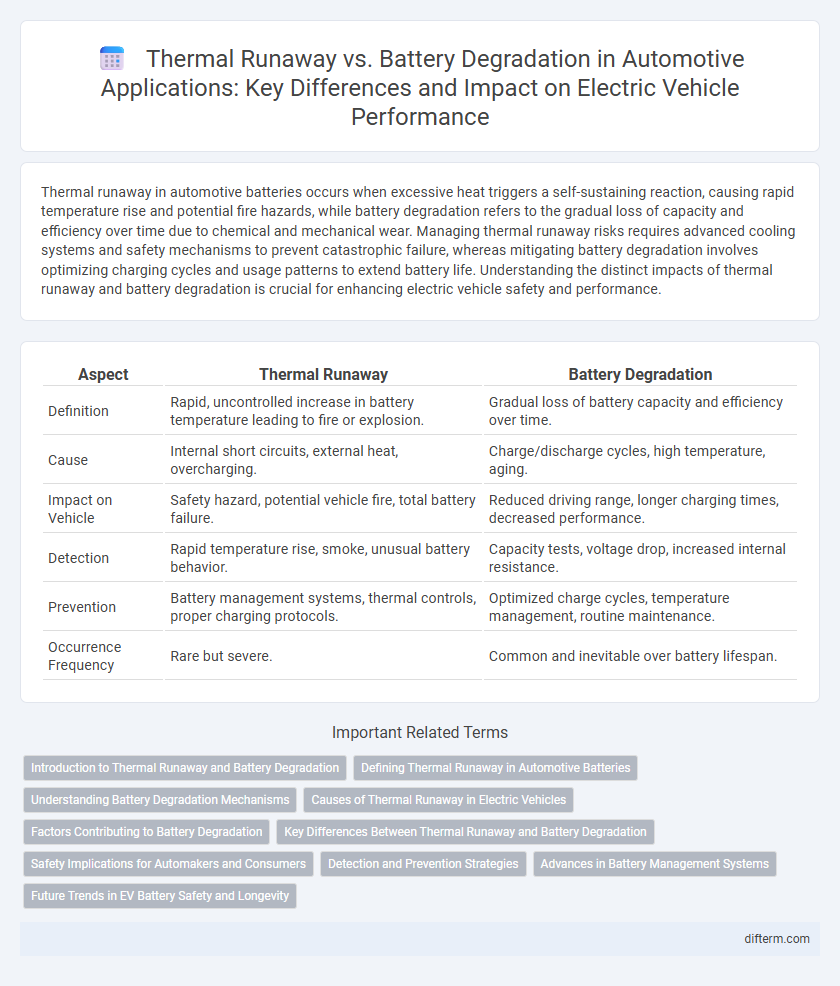Thermal runaway in automotive batteries occurs when excessive heat triggers a self-sustaining reaction, causing rapid temperature rise and potential fire hazards, while battery degradation refers to the gradual loss of capacity and efficiency over time due to chemical and mechanical wear. Managing thermal runaway risks requires advanced cooling systems and safety mechanisms to prevent catastrophic failure, whereas mitigating battery degradation involves optimizing charging cycles and usage patterns to extend battery life. Understanding the distinct impacts of thermal runaway and battery degradation is crucial for enhancing electric vehicle safety and performance.
Table of Comparison
| Aspect | Thermal Runaway | Battery Degradation |
|---|---|---|
| Definition | Rapid, uncontrolled increase in battery temperature leading to fire or explosion. | Gradual loss of battery capacity and efficiency over time. |
| Cause | Internal short circuits, external heat, overcharging. | Charge/discharge cycles, high temperature, aging. |
| Impact on Vehicle | Safety hazard, potential vehicle fire, total battery failure. | Reduced driving range, longer charging times, decreased performance. |
| Detection | Rapid temperature rise, smoke, unusual battery behavior. | Capacity tests, voltage drop, increased internal resistance. |
| Prevention | Battery management systems, thermal controls, proper charging protocols. | Optimized charge cycles, temperature management, routine maintenance. |
| Occurrence Frequency | Rare but severe. | Common and inevitable over battery lifespan. |
Introduction to Thermal Runaway and Battery Degradation
Thermal runaway in automotive batteries occurs when excessive heat causes uncontrollable chemical reactions, leading to rapid temperature increases and potential fire hazards. Battery degradation involves the gradual loss of capacity and performance due to factors like charge cycles, temperature, and chemical changes within lithium-ion cells. Understanding the distinction between thermal runaway and battery degradation is critical for improving electric vehicle safety and extending battery lifespan.
Defining Thermal Runaway in Automotive Batteries
Thermal runaway in automotive batteries refers to an uncontrollable increase in temperature triggered by internal short circuits or excessive current, resulting in rapid energy release and potential fire hazards. Unlike gradual battery degradation caused by cyclic aging and chemical breakdown, thermal runaway is an acute, dangerous event often linked to lithium-ion cell instability. Accurate monitoring of temperature, voltage, and internal resistance is critical for early detection and prevention of thermal runaway in electric vehicles.
Understanding Battery Degradation Mechanisms
Thermal runaway is a critical failure mode in lithium-ion batteries characterized by uncontrollable temperature rise, leading to rapid capacity loss and safety hazards. Battery degradation mechanisms, including solid electrolyte interface growth, lithium plating, and active material loss, gradually reduce performance and lifespan under normal operating conditions. Understanding the interplay between thermal runaway events and progressive degradation is essential for optimizing battery management systems and enhancing automotive battery safety and durability.
Causes of Thermal Runaway in Electric Vehicles
Thermal runaway in electric vehicles is primarily caused by internal short circuits, overcharging, and exposure to high temperatures, which lead to uncontrollable heat generation within lithium-ion battery cells. Battery degradation exacerbates this risk by increasing internal resistance and creating hotspots that accelerate chemical reactions. Factors such as mechanical damage, manufacturing defects, and poor battery management system (BMS) performance also contribute significantly to the onset of thermal runaway events.
Factors Contributing to Battery Degradation
High temperatures accelerate chemical reactions in lithium-ion batteries, leading to electrolyte breakdown and increased internal resistance, which significantly contributes to battery degradation. Repeated exposure to thermal runaway events causes irreversible damage to the battery's cathode and anode materials, reducing overall capacity and lifespan. Managing heat generation and dissipation through advanced cooling systems is critical to minimizing degradation rates and enhancing battery safety and durability in electric vehicles.
Key Differences Between Thermal Runaway and Battery Degradation
Thermal runaway in automotive batteries is an uncontrolled, rapid increase in temperature causing potential combustion, whereas battery degradation refers to the gradual loss of capacity and performance over time. Thermal runaway poses immediate safety hazards due to its explosive nature, while battery degradation impacts long-term efficiency and range. Understanding these distinctions is critical for optimizing electric vehicle battery management systems and ensuring driver safety.
Safety Implications for Automakers and Consumers
Thermal runaway in automotive batteries poses acute safety risks such as fires and explosions, demanding rigorous monitoring and advanced cooling systems from automakers. Battery degradation decreases energy efficiency and lifespan, increasing the likelihood of thermal events and impacting vehicle reliability. Implementing robust safety protocols and real-time diagnostics helps mitigate these dangers, protecting consumers and enhancing overall electric vehicle safety.
Detection and Prevention Strategies
Thermal runaway detection relies on advanced sensor arrays monitoring temperature spikes, voltage fluctuations, and gas emissions within lithium-ion battery cells. Prevention strategies integrate robust battery management systems (BMS) employing real-time state-of-charge and state-of-health analytics to mitigate overcharging, overheating, and internal short circuits. Enhanced cooling techniques and thermal barriers further suppress propagation risks, extending battery lifespan and reducing degradation rates.
Advances in Battery Management Systems
Advances in Battery Management Systems (BMS) significantly mitigate thermal runaway risks by continuously monitoring temperature, voltage, and current across individual cells to ensure balanced and safe operation. Enhanced algorithms and real-time data analytics within modern BMS optimize battery degradation patterns, extending overall battery life and maintaining performance consistency. Integration of predictive maintenance techniques allows early detection of potential thermal events, promoting safer and more reliable electric vehicle battery operation.
Future Trends in EV Battery Safety and Longevity
Future trends in EV battery technology emphasize advanced thermal management systems to prevent thermal runaway, incorporating solid-state electrolytes and enhanced cooling techniques. Innovations in battery chemistry and AI-driven monitoring extend battery longevity by minimizing degradation through precise control of charge cycles and temperature. Enhanced safety protocols and predictive maintenance are set to revolutionize electric vehicle reliability and lifecycle performance.
thermal runaway vs battery degradation Infographic

 difterm.com
difterm.com